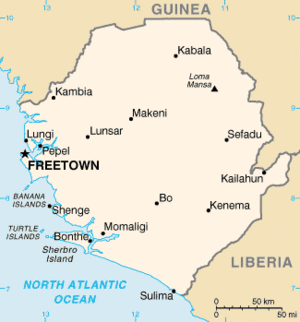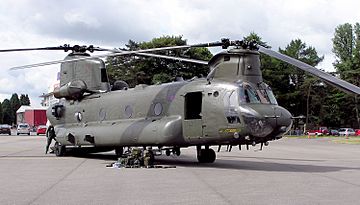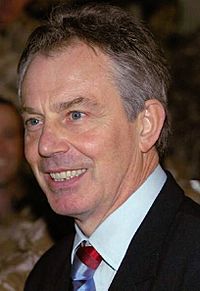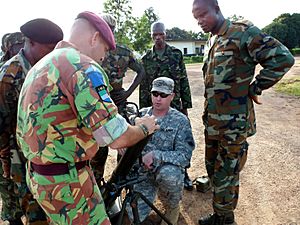British military intervention in the Sierra Leone Civil War facts for kids
The United Kingdom started a military mission in Sierra Leone on May 7, 2000. It was called Operation Palliser. While some British people were already there, this was the first big mission by British forces in the Sierra Leone Civil War. In early May 2000, the Revolutionary United Front (RUF), a main group in the war, moved towards Freetown, the country's capital. This made the British government send a team to get ready to help foreign citizens leave. On May 6, the RUF blocked the road from Freetown to Lungi, the main airport. The next day, British soldiers began to make the airport and other important areas safe for people to leave. Most people who wanted to go were evacuated in the first two days. But many chose to stay after British forces arrived.
After the evacuation was mostly done, the British mission grew. They helped rescue peacekeepers who were surrounded, including some British ceasefire observers. They also started helping the United Nations Mission in Sierra Leone (UNAMSIL) and the Sierra Leone Army (SLA). Even with the bigger mission, British soldiers did not meet the RUF directly until May 17. The rebels attacked a British spot near Lungi airport. But they had to leave after several fights. On the same day, the RUF's leader, Foday Sankoh, was caught by Sierra Leonean forces. This left the RUF in confusion. The British decided the RUF would not give up their weapons on their own. So, they began training the SLA for a fight. During this training, a group of soldiers returning from visiting Jordanian peacekeepers was captured by a group called the West Side Boys. Talks led to five of the eleven soldiers being freed. Three weeks later, British special forces launched a mission called Operation Barras. They freed the last six soldiers. This success made people trust the British mission again. One expert said that if it had failed, the British government would have had to pull all its forces out of Sierra Leone.
The main British operation was mostly finished by September 2000. The RUF started to give up their weapons after political pressure and money rules were put on Liberia. Liberia had helped the RUF in exchange for conflict diamonds smuggled from Sierra Leone. The Sierra Leonean government later signed a ceasefire with the RUF. This meant the RUF had to join the Disarmament, Demobilisation, and Reintegration (DDR) process. By September 2001, when British training teams were replaced by an international force, the DDR process was almost done. British forces kept helping Sierra Leone. They sent the most people to the international training team. They also gave advice on how to rebuild Sierra Leone's armed forces. A small group of soldiers was sent to the area in 2003. This was to keep things stable while the Special Court for Sierra Leone made arrests. The success of British operations in Sierra Leone showed that keeping forces ready to act quickly was a good idea. The Prime Minister, Tony Blair, wanted to see Western countries help in other conflicts. He supported creating European Union Battlegroups for this purpose. But political disagreements and later British missions in Afghanistan and Iraq stopped more British operations in Africa.
Contents
Understanding the Situation in Sierra Leone
What is Sierra Leone?
Sierra Leone is a country in West Africa, near the equator. It is about the size of South Carolina or Scotland. It shares land borders with Guinea and Liberia. The Atlantic Ocean is to its west. The country became a British colony in 1808. But British influence started earlier. In the late 1700s, former slaves settled in the area that became Freetown, now the capital city. Freetown is on a peninsula. It is separated from the main airport, Lungi, by the wide Sierra Leone River estuary. Sierra Leone became independent from the United Kingdom in 1961.
In 1978, Sierra Leone became a one-party state. The All People's Congress (APC) was the only legal political party. In 1985, Joseph Momoh became president. He was accused of corruption. The Revolutionary United Front (RUF) was formed to overthrow him. With help from Liberia, the RUF began attacking border towns in 1991. They quickly took control of diamond mines. They smuggled these diamonds through Liberia to trade for weapons. The next years saw many changes in power and help from other countries. A bloody civil war badly damaged the country.
On July 7, 1999, the Lomé Peace Accord was signed. This agreement called for an immediate ceasefire. It also said the Sierra Leone Army (SLA) and the RUF should give up their weapons. The agreement also made the RUF a legal political party. They were given a role in the government. Foday Sankoh, the RUF leader, was put in charge of the diamond mines. Many people criticized this because of the RUF's history of smuggling diamonds.
Why Did the UK Get Involved?
The intervention in Sierra Leone was the fourth military mission for the British under Prime Minister Tony Blair. He was elected in 1997. Blair believed in using military force to protect people. He called this "humanitarian intervention." He felt it was right to act when there was a strong moral reason. The mission in Sierra Leone seemed to fit his ideas.
Before the big mission in May 2000, British people had already been in Sierra Leone. In May 1997, a small British Army team went to train SLA officers. But a coup happened before training could start. In February 1998, HMS Cornwall brought food and medical supplies. Her crew helped fix things. Later in 1998, the Royal Air Force (RAF) helped about 80 British people leave the country. In January 1999, the RUF attacked Freetown. HMS Norfolk was sent to help. British officials used the ship as a base. Later, HMS Westminster took its place. The fighting ended with the Lomé Peace Accord in July 1999. The United Nations Mission in Sierra Leone (UNAMSIL) was set up. It included a small number of British officers.
Getting Ready for the Mission
RUF Advances and UN Concerns
UNAMSIL set up camps to disarm soldiers and militia groups. The SLA and some militias joined, but the RUF did not. In April 2000, the RUF attacked UNAMSIL bases. They took many UN staff as prisoners. Then they started moving into areas the Sierra Leone government controlled. On May 3, the RUF took the town of Kambia. Foreign officials thought the RUF could reach Freetown in a week. This was because the SLA had given up most of its weapons. The United Nations asked the UK, as the former colonial power, to step in directly.
On May 5, 2000, the British government said it would only give support to UNAMSIL. But they were secretly looking at military options. The UK had put a lot of effort into Sierra Leone. They did not want to see it fail. Also, about 1,000 British people were in Sierra Leone. The government worried about their safety. Experts later said that if the UN mission failed, it would hurt trust in future UN peacekeeping. British military leaders said a mission in Sierra Leone was possible.
Planning the Evacuation
The British government's emergency committee, COBRA, met. They looked at three ways to evacuate people. They could send aircraft and special forces to Lungi airport. Or they could send regular ground forces for a similar job. Or they could send a group of navy ships. COBRA decided they needed more information. They asked the military to keep planning. They also said an "operational reconnaissance and liaison team" (ORLT) should go to Sierra Leone. This team would check the situation and advise on how the military could help. Prime Minister Tony Blair approved the ORLT. It was led by Brigadier David Richards. He knew Sierra Leone well. He and his team arrived in Freetown early on May 6. They set up in the British High Commission.
Other military groups were also put on high alert on May 5. Two Royal Navy ships, HMS Illustrious and HMS Argyll, were ordered to sail to the area. A special forces squadron and the 1st Battalion, Parachute Regiment (1 PARA) were told to get ready. Several RAF transport planes were prepared to fly special forces or 1 PARA to Lungi airport. Also, four RAF CH-47 Chinook helicopters were sent to Sierra Leone. Two came from the Balkans and two from the UK. The RAF did not have planes big enough to carry the Chinooks. So, the helicopter crews flew them themselves to Freetown. The 3,000-mile flight from the UK was the longest self-deployment of helicopters in British history.
Operation Palliser Begins
On May 6, 2000, the RUF blocked the road to Lungi Airport. UNAMSIL staff moved to a hotel to get ready to leave Sierra Leone if the RUF kept moving towards Freetown. Because of this, Brigadier Richards asked for British troops to be sent to Dakar, Senegal. This would make it faster to start a mission in Sierra Leone. Richards also talked to the 1 PARA command. The 1 PARA group then moved to a military center in Gloucestershire. The next day, Richards was put in charge of the British mission. He and the British High Commissioner, Alan Jones, were given power to start an evacuation.
The RUF was quickly moving towards Freetown. The only way to quickly get people out or send help to UNAMSIL was by air through Lungi airport. So, the 1 PARA group flew to Dakar on May 7. Some of them immediately got on RAF Hercules C-130 planes. Their orders were to secure the airport. They arrived at Lungi before sunset. The rest of 1 PARA joined them the next morning. The soldiers quickly secured key areas for the evacuation, including the Mamy Yoko hotel, which became the evacuation center, and Lungi airport. On the afternoon of May 8, Jones asked Richards to start the evacuation. Richards began it right away. It was called Operation Palliser. People who wanted to leave were told to go to the Mamy Yoko hotel. From there, Chinooks would fly them to the airport. Then planes would take them to Dakar.
Over one week, British forces helped about 500 people leave Sierra Leone. Almost 300 left in the first two days. The arrival of British soldiers made people feel much better. Many foreign citizens decided to stay. The operation slowed down after the first two days. But soldiers and aircraft stayed ready to help anyone who could not reach Freetown earlier. They also stayed ready to evacuate the British High Commission if things got worse.
Expanding the Mission
Helping Peacekeepers and the SLA
With the evacuation mostly done, the British government focused on four British UN military observers (UNMOs) held by the RUF. British forces in Freetown helped four UNMOs (three British and one from New Zealand) escape from a UNAMSIL camp. This camp had been surrounded by the RUF. The officers left the camp secretly and walked west. An RAF Chinook picked them up and flew them to Freetown. Only one British UNMO, Major Andy Harrison, was still held by the RUF. The British government started trying to find him.
The British mission had boosted morale and stopped the RUF advance. But there were worries that violence would start again once the British left. The United Nations wanted the British forces to join UNAMSIL. But the British military did not trust UNAMSIL's leadership. They also did not want to send a very large force. So, the British forces stayed separate from UNAMSIL. The British government also did not want to commit troops to a long peacekeeping mission. This was because some politicians and media in the UK were against the mission. However, the mission was well-received by other countries and the UN Security Council.
On May 12, a British minister said that British forces would stay in Sierra Leone. Their main job was to keep Lungi airport safe while UNAMSIL brought in more troops. Soldiers also stayed in Freetown to keep the evacuation point safe. Others patrolled the streets to reassure people. HMS Illustrious and other ships arrived on May 14. This brought the total number of British personnel to about 4,500. Harriers from Illustrious flew patrols over Freetown. The British forces helped UNAMSIL and the SLA. They also got ready to give humanitarian aid if needed. The RUF started to gather forces again in the north. The RAF Chinooks helped move UNAMSIL reinforcements from Lungi. President Ahmad Kabbah formed an alliance of militia groups and the remaining SLA soldiers. This group of about 6,000 people helped UNAMSIL stop the RUF. The British also provided information to UNAMSIL using ground teams and Harriers.
The RUF kept advancing. On May 17, they met British forces directly. The Pathfinder Platoon was in a village called Lungi Lol, near Lungi airport. They were attacked by RUF members. Several hours of fighting followed. The RUF left, with 30 casualties. Brigadier Richards said the British success was a huge psychological victory. Foday Sankoh, the RUF leader, was captured later that day. He was handed over to the Sierra Leone Police. But he had to be flown out by an RAF Chinook because a crowd gathered. Sankoh's capture caused confusion among the RUF. The British military decided to rotate their forces. The 1 PARA group went back to the UK. 42 Commando, Royal Marines, came to replace them.
On May 23, the British government set out its long-term goals for the mission. These included bringing peace and security to Sierra Leone. They also wanted to support UNAMSIL, prevent another disaster in Freetown, and free captive UN personnel. Finally, they wanted to avoid British casualties and find a way to leave without harming UNAMSIL or the Sierra Leonean government.
Operation Khukri: Rescuing Hostages
The British government especially wanted to free Major Andy Harrison, the last British UNMO held by the RUF. Harrison and other UNMOs were protected by Indian Army soldiers. These soldiers were surrounded by the RUF in Kailahun. The British and Indian military leaders had a plan to get the UNMOs out. British special forces were ready. But the UN and British leaders worried the RUF would hurt other surrounded UNAMSIL forces if the UNMOs were taken by force. So, Major-General Vijay Kumar Jetley, the UNAMSIL commander, was allowed to keep talking for their release.
When the last surrounded group (except Kailahun) was evacuated on May 30, plans for a military rescue grew. This mission, called Operation Khukri, started on July 10. Two RAF Chinooks flew Indian special forces near Kailahun. The helicopters returned to Freetown with Harrison, his fellow UNMOs, and some Gurkhas who were hurt. Harrison was safely rescued. The 600 Gurkhas fought their way out of Kailahun, with one casualty.
Training the Sierra Leone Army
The British government decided that the RUF could not be trusted. They would have to be forced to join the UN's Disarmament, Demobilisation, and Reintegration (DDR) process. The British looked at three options: send British forces against the RUF, have UNAMSIL fight the RUF, or have the Sierra Leonean government use its loyal forces. Brigadier Richards thought fighting the RUF directly would need at least 5,000 British troops. But sending so many troops was not popular in the UK. The British military also had other missions. So, using British forces to fight the RUF directly was ruled out. A UNAMSIL-led fight was also ruled out. UNAMSIL's job was peacekeeping, not fighting.
This left the SLA and its allied militia groups. These groups became known as the "Unholy Alliance." They were the only ones who could fight the RUF. The SLA had given up its weapons. To rebuild it, the UN lifted its arms ban on Sierra Leone. British forces began advising and training the SLA. A British Short-Term Training Team (STTT) was sent to improve the SLA's infantry skills. This mission was called Operation Basilica. It was based at the Benguema Training Centre. The first unit was about 250 people from the 2nd Battalion, The Royal Anglian Regiment. They arrived on June 15 to train 1,000 SLA recruits. The training taught them about the Geneva Convention, teamwork, and other skills to make the SLA a professional army.
Even with British training, the SLA was not strong enough to fight the RUF and hold the land they took back. So, the British convinced UNAMSIL to move forward behind the SLA. This would help defend the recaptured land. British officers also helped UNAMSIL and SLA commanders plan operations.
Operation Barras: Freeing Captured Soldiers
A group from the 1st Battalion, The Royal Irish Regiment, replaced the Anglians. On August 25, a patrol from the Royal Irish visited a militia group called the West Side Boys (WSB). At the village of Magbeni, the Royal Irish soldiers were captured. British officers talked with the WSB. This led to five of the eleven soldiers being freed on August 31.
On September 9, the WSB said the remaining six soldiers would only be freed if a new government was formed in Sierra Leone. This made negotiators think the WSB was just delaying. At the same time, teams watching the WSB base had not seen the captive soldiers for four days. There were also worries that a rescue would be more dangerous if the WSB moved the hostages. Because of these reasons, COBRA ordered a rescue mission.
The mission, called Operation Barras, was carried out by D Squadron of 22 Special Air Service Regiment. They attacked the village of Gberi Bana to rescue the soldiers. At the same time, a company from 1 PARA attacked Magbeni, on the other side of Rokel Creek. The mission was a success. All the British captives were rescued. Their SLA helper and 22 Sierra Leonean civilians were also freed. The WSB was defeated as a fighting force. One British soldier and at least 25 West Side Boys were killed. Many other West Side Boys ran away and later gave up to Jordanian peacekeepers. Some of those who surrendered later joined the new Sierra Leone Army. They went into the British-run training program. After Operation Barras, two SLA battalions, who had been trained by the British, cleared the area around the West Side Boys' camp.
The British military knew Operation Barras was risky. One SAS soldier called it a "very grubby, green operation with lots of potential for things to go wrong." But experts said the mission showed that the British government was willing to risk casualties for a good cause. During the crisis, some politicians wanted to end the British mission in Sierra Leone. Experts suggested that the success or failure of Operation Barras was linked to the fate of the whole British operation. If British forces had been defeated, the UK might have had to pull all its forces out of Sierra Leone.
Ending the Conflict
Facing the RUF and Ceasefire
The capture of the Royal Irish patrol showed the British government that their efforts were not enough to end the civil war. In the UK, politicians against the mission again spoke out. The government wanted a way to end the mission without abandoning Sierra Leone.
In August 2000, the United Nations Security Council passed Resolution 1313. This resolution blamed the RUF for the ongoing conflict. It allowed UNAMSIL to grow and gave it stronger powers. The UN again asked the British government for troops. Some countries did not want to send their own troops without help from Western nations. They felt the UK should contribute to the UN mission.
Despite the pressure, the British military still did not trust UNAMSIL's leadership. So, the British government refused to put its combat troops under UN command. But they did send more staff officers to UNAMSIL, to the UN headquarters in New York, and to the SLA. These officers helped UNAMSIL commanders plan operations. In New York, officers helped plan how to get supplies to UNAMSIL. At the same time, the British training program changed. The SLA still needed many combat support skills and better command. The STTTs started giving more specialized training to new recruits. British trainers also built an operations room at the SLA's headquarters. They also helped improve the SLA's communications and logistics.
Resolution 1313 changed UNAMSIL's approach. It moved from being neutral to supporting the Sierra Leone government. This made some countries contributing troops uncomfortable. Jordan and India, two of the largest contributors, decided to pull their forces out. This happened at the end of the rainy season. There were fears the RUF would start moving towards Freetown again. The UN and British government worried UNAMSIL would be vulnerable. To deter the RUF, the British navy ships were again sent off the coast. They performed landing demonstrations to show their strength.
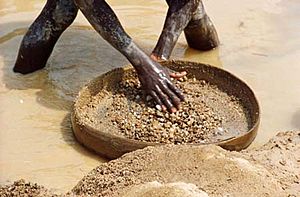
The RUF was under increasing pressure from politics and the British-trained SLA. The RUF relied heavily on Liberia, led by Charles Taylor. Most of its money came from selling diamonds smuggled through Liberia. These became known as blood diamonds. In late 2000, the Sierra Leone government, with support from the British, UNAMSIL, and ECOWAS, started talks with the RUF. On November 10, the two sides signed a 30-day ceasefire. This allowed UNAMSIL to go throughout the country. It also said the RUF should return seized weapons and join the DDR process. The ceasefire was later extended for 90 more days. The UN Security Council banned Liberian diamonds in March 2001. Soon after, the RUF began giving up many weapons. By September, over 16,000 militia members, including about 6,500 RUF, had gone through the DDR process. All fighters in the diamond areas had disarmed.
By March 2002, over 50,000 people had gone through the DDR process. The RUF was completely disarmed. A company of Gurkhas and a Royal Navy ship were sent in March 2003. This was to keep things stable while important people, including Charles Taylor, were arrested by the Special Court for Sierra Leone.
The last British training team left Sierra Leone in September 2001. About 8,500 SLA soldiers were trained. These teams were replaced by the International Military Assistance and Training Team (IMATT). This group had people from countries like Australia, Canada, and the United States. The UK sent the most people. The British teams also formed a small special forces unit within the SLA. This was called the Force Reconnaissance Unit (FRU). Later in 2001, the British Army advised the Sierra Leonean government on combining its armed forces. This became the Republic of Sierra Leone Armed Forces in early 2002. In 2008, the permanent British presence in Sierra Leone was reduced to 100 people. British soldiers were still in Sierra Leone in 2013. They continued to be part of IMATT.
What Was the Impact?
According to Peter Penfold, who was the British High Commissioner, the fact that Nigeria and the UK took an active interest was key to ending the conflict. He also said that Brigadier Richards' leadership was "extremely fortunate." Richards knew he could do more than just help with an evacuation. He realized he could help stabilize the situation. Richards received an award for his leadership.
The mission in Sierra Leone was the fourth time British forces were sent abroad under Tony Blair. It was the largest mission the UK did alone since the Falklands War (1982). Unlike Afghanistan and Iraq, the mission in Sierra Leone was seen as a success. It became a model for successful military operations. Blair used it to explain later missions. Success in Sierra Leone encouraged the Blair government to keep helping Africa solve conflicts.
Sierra Leone also supported Blair's idea of humanitarian intervention. Critics said it made Blair see military force as just another option. In his book, Blair said the operation was one of the things he was most proud of. He wanted to help other African nations where people were in danger. But a lack of political support and big missions in Afghanistan and Iraq stopped more interventions in Africa. It was not until 2011 that the UK took part in another military mission in Africa.
The experience in Sierra Leone showed that a small number of well-trained soldiers could be very effective. It made the British government work more closely with European allies, especially France. After a meeting in 2003, the two governments asked the European Union (EU) to create battle groups. These groups would be about 1,500 soldiers ready to act quickly in crises, especially in Africa. EU countries approved the creation of 13 battle groups in 2004.
Sierra Leone convinced Blair and his Defence Secretary Geoff Hoon that British defense policy needed to change. It needed to focus on less traditional conflicts. In 2003, the British military published a report. It recommended preparing for short, intense operations against weaker forces. It especially focused on Africa.
The speed needed to send forces to Sierra Leone showed the UK needed to keep forces ready to act quickly. This also proved the value of concepts like the Amphibious Ready Group and the spearhead battalion (like 1 PARA). The 2004 review of the infantry structure protected 1 PARA. This review reduced the number of British Army battalions. It also created the Special Forces Support Group (SFSG). This group was inspired by 1 PARA's success in Operation Barras. The SFSG helps British special forces on large missions. The mission in Sierra Leone was the first big test of the ORLT and joint task force ideas. These were created to provide a headquarters ready to command a mission quickly. According to Richards, both were "thoroughly validated." They were vital in coordinating the many resources sent quickly.
A 2015 study found that the intervention in Sierra Leone was a success.


